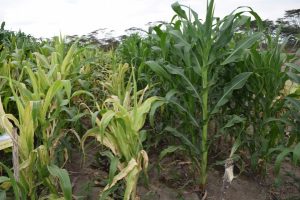Kenya
July 24, 2017
by B.M. Prasanna

Germplasm at the Naivasha MLN screening site, Kenya. Photo: B.Wawa/CIMMYT
The new maize lethal necrosis (MLN) online portal provides up-to-date information and surveillance tools to help researchers control and stop the spread of the deadly disease.
MLN was first reported in Kenya in 2011 and has since then been reported in several countries in eastern Africa, especially the Democratic Republic of the Congo, Ethiopia, Kenya, Rwanda, Tanzania and Uganda. The disease kills plants before they can grow, and the pathogens are transmitted by insects or contaminated seed. Serious damage to the region’s maize production from MLN has impacted household food security.
The online portal, found at mln.cimmyt.org, details the spread of MLN, where the disease has been managed and controlled, and how to identify it in the field. It also provides key MLN publications, surveillance software, MLN incidence maps, information on the MLN Screening Facility, and MLN-tolerant hybrids that are either released or in pipeline.
One tool on the portal is the MLN surveillance and monitoring system that provides real-time data to identify the presence and spread of the disease across five endemic countries in eastern Africa, and three selected non-endemic countries in southern Africa. The system was developed by scientists collaborating with the International Maize and Wheat Improvement Center (CIMMYT), with support from the United States Agency for International Development (USAID).

MLN susceptible hybrids compared to a CIMMYT-derived MLN-tolerant hybrid. Photo: CIMMYT
In 2016, MLN surveillance was successfully conducted in Malawi, Zambia and Zimbabwe – three major seed producing countries in Africa – and the data is presented in the portal, detailing MLN’s status across 652 surveyed maize fields. Future data gathered in other affected countries will also be uploaded to the portal as surveillance teams conduct fieldwork using Global Positioning System online survey tools, to assess the spread and severity of the disease in these countries. Ongoing surveillance in endemic countries allows stakeholders to see real-time updates on the spread of MLN.
Since the disease was first reported, collaborative efforts have resulted in the establishment of a MLN Screening Facility at the Kenya Agricultural & Livestock Research Organization (KALRO) center at Naivasha in 2013. The facility, managed by CIMMYT, has so far screened nearly 100,000 maize germplasm entries — 56 percent from CIMMYT — against MLN under artificial inoculation over the last four years.
Nine CIMMYT-derived MLN-tolerant hybrids have been already released in three countries – seven in Kenya, one in Uganda and one in Tanzania. Eleven second generation hybrids are currently in national performance trials in these countries. Intensive efforts are currently being made by seed companies in Kenya, Tanzania and Uganda to expand the delivery of MLN-tolerant maize seed to the smallholders.
The MLN portal enables researchers to comprehensively assess the situation with regard to MLN, helps strengthen the national disease monitoring and diagnostic systems by providing faster and accurate data, and offers access to CIMMYT-offered MLN phenotyping services.
Dr. B.M. Prasanna. Director, Global Maize Program, International Maize and Wheat Improvement Center (CIMMYT) and the CGIAR Research Program MAIZE. He is also the project leader of the MLN diagnostics and management project.